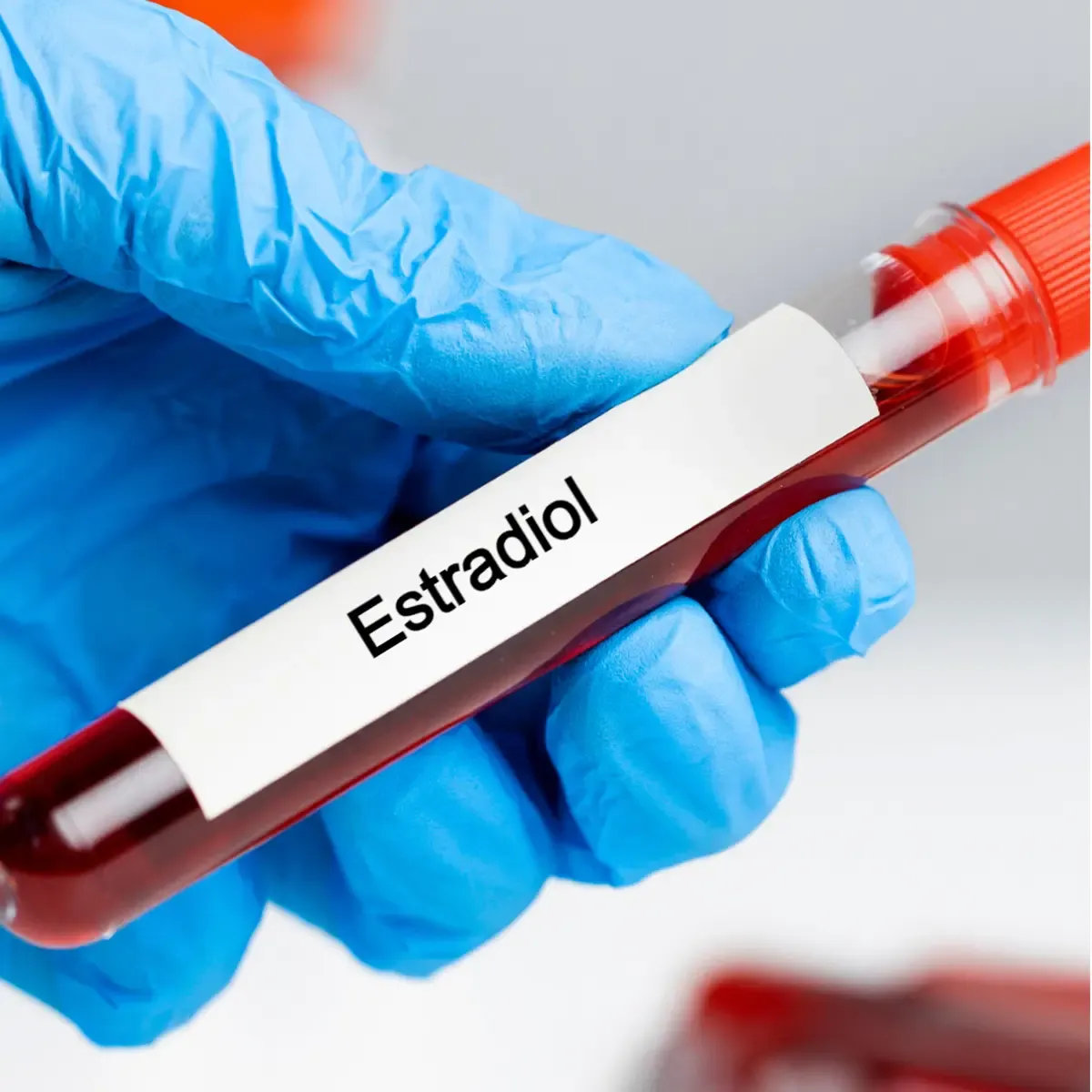Estradiol (E2) Lab Test
Estradiol (E2)
You Should Know Your Estradiol (E2) Level
The body makes three estrogens: Estrone (E1), Estradiol (E2) and Estriol (E3). These are known as gonadal hormones associated with reproductive health. These three hormones need to be kept in balance to prevent excessive proliferation of cells that could lead to severe, PMS, Endometriosis, Ovarian Cysts and even breast, ovarian or uterine cancer.
The two most concentrated and most potent estrogens are Estrone (E1) and Estradiol (E2). They are the hormones responsible for your monthly Cycle. They work together to stimulate cell growth of the uterine lining and breast tissue associated with the preparation for pregnancy.
Estrone and Estradiol are made by the Ovarian Follicle, the Adrenal gland from DHEA or in adipose-fat tissue from Testosterone.
BENEFITS of Estrone and Estradiol
- Releasing mature eggs during the menstrual cycle.
- Thickening the uterine lining to prepare for fertilization.
- Bone health.
- Cognitive function, including your ability to focus.
- Collagen production , thickness and moisture of your skin.
- Production of nitric oxide, a molecule that improves kidney filtration rate, helps blood vessels open, reduces elevated BP and increased erectile function in both men and women.
Symptoms of Excessive Estrone or Estradiol:
- Depression or anxiety.
- Fatigue.
- Heavy periods.
- Fibrocystic Breast Disease (Noncancerous fibrous lumps in breast tissue).
- Severe premenstrual syndrome (PMS).
- Migraines.
- Uterine fibroids.
- Weight gain in the hips, thighs or waist.
High Estrone and/or Estradiol in Men:
- Enlarged breast tissue (gynecomastia).
- Erectile dysfunction.
- Infertility.
The key difference between Estradiol and Estrone, is that Estradiol is the principal hormone that directs the Menstrual Cylce by stimulating cellular proliferation. Every month during a woman's years of fertility, from puberty to menopause, you should be having a regular, twenty-eight day menstrual cycle.
Menstrual Cycle: An optimal menstrual cycle should last 4 weeks, from one Period to the next. The first 2 weeks, or days 1-14, of your Cycle is the Follicular Phase. Ovulation should occur on day 14, followed by a 2 week Luteal Phase, on days 15-28.
Follicular Phase: Each month, during the Follicular Phase, Follicle Stimulating Hormone (FSH) from your pituitary gland activates your ovaries to start producing follicles, the fluid-filled sacs where your eggs mature. As many as 10-20 Follicles form in your ovaries each month. Only one egg matures inside each Follicle. During this phase each month, only one Follicle and Egg matures completely. Estrone and Estradiol gradually increase during this phase. Thse two hormones along with Estriol (E3) keep your vaginal walls thick, elastic and lubricated, reducing pain associated with intercourse. Estrone and Estradiol thin your vaginal mucous to assist the migration of sperm through the vagina to reach the egg soon to be released. Estrone and Estradiol rise to their highest point at the end of the Follicular Phase, which triggers the cessation of FSH production and a surge of Lutenizing Hormone (LH) on day 13. This marks the end of the Folliclular Phase.
Ovulation. The sudden elevated surge of Estradiol and LH triggers Ovulation on day 14 and the release of the most mature egg into the fallopian tube adjacent to that Ovary. The egg then begins traveling down the fallopian tube toward the Uterus. If sperm are in the area, the first one to reach the egg and penetrate the membrane will fertilize the egg and unite to form a zygote. This is the moment of conception of a baby human being. The increasing levels of Estrone and Estradiol during the Follicular Phase stimulate cellular proliferation of the uterus and the breast tissue to prepare the uterine lining for implantation, support and proliferation of all the necessary auxiliary tissue necessary for growth and nuture of the baby, including breast tissue and mammary glands to nurse the baby.
Luteal Phase: During the luteal phase, the dominant follicle that released the mature egg changes into a structure called the Corpus Luteum. The corpus luteum now begins to produce high levels of Progesterone and much lower levels of Estrone and Estradiol. If no sperm find your egg, you won’t get pregnant and the Corpus Luteum get the message to stop producing Progesterone, Estrone and Estradiol.
Menstruation: When conception does not occur a chemical /hormonal message causes a sudden drop in Progesterone, Estrone and Estradiol, which triggers the sloughing off of your uterine lining and the onset of your menstrual bleeding. It should take 5-7 days to shed your uterus lining (menstruation).
Concerns of Excessive Estrone and/or Estradiol:
Because they stimulate cell growth, they can also stimulate cancer cell growth. Both Estrone and Estradiol are now classified as carcinogens. A woman cannot make a baby without them, but too much can cause cancer, so nature gave women three hormones for balance. When a woman becomes pregnant, she stops making high levels of Estrone and Estradiol and starts making lots of Estriol. This increased balance of Estriol decreases cellular proliferation and reduces a woman’s risk of getting breast cancer by 7% for every pregnancy and 4% more for every baby she breast feeds for at least 12 months.
Testing and keeping your hormones in Optimal Balance is the best proactive strategy you can take to prevent Breast, Ovarian and Uterine Cancer.
Testing Details
Sample Type: Blood Serum
Collection Method: In person at Hansen Clinic
Timing for Blood Testing: Test should be taken on day 21 of a 28-day cycle, or 7 days before the start of your next menstrual period. The first day of your bleeding menstrual period is considered day 1 of your menstrual cycle.
If you’re taking a supplement containing biotin (also called vitamin B7), commonly found in products promoting nail, skin and hair health, it is recommended that you wait at least 72 hours after your last dose before getting this blood test.

